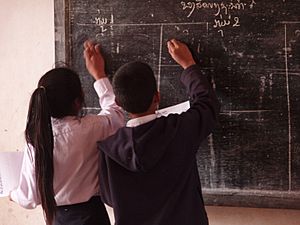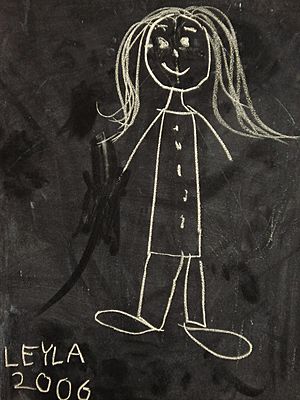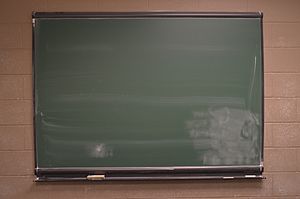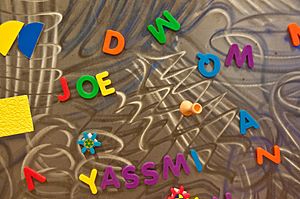Blackboard facts for kids
A blackboard, also known as a chalkboard, is a surface where you can write using chalk. It's like a big, reusable notepad often found in classrooms.
Blackboards were once very common in schools to help teachers explain things. However, they are not used as much today. Many schools now use whiteboards instead. This is partly because some people are sensitive to chalk dust. Also, chalk dust can be a bit messy to clean up.
The chalk used on blackboards isn't the same as the natural rock chalk. Instead, it's usually made in factories. Blackboards can be black or dark green. You can only write on them with chalk.
Contents
How Blackboards Are Made

A simple blackboard can be just a piece of wood painted with a dark, non-shiny paint, usually black or dark green. Sometimes, special black plastic material is also used to make cool chalkboard art.
A more modern type of blackboard has a long sheet of plastic that rolls up and down between two rollers. This lets you scroll to new writing space while keeping what you've already written. The best quality blackboards are made from a rough type of porcelain enamel on a steel base. Porcelain is very strong, so these blackboards can last for 10 to 20 years, even with lots of use.
Blackboards made from slate started being produced around the 1840s. Green chalkboards, which are usually made of porcelain enamel on steel, first appeared in the 1960s.
In large lecture halls, you might see several blackboards arranged in a grid. A teacher can move these boards closer to write on them, then move them away. This allows a lot of information to be shown at once.
Chalk marks are easy to wipe off. You can use a damp cloth, a sponge, or a special blackboard eraser. This eraser is usually a block of wood covered with a felt pad. However, if a blackboard is wet, chalk marks can sometimes be hard to remove. Manufacturers often suggest covering a new blackboard completely with chalk and then wiping it off. This helps prepare the surface for use.
Chalk Sticks
Chalk sticks are made especially for blackboards. They come in white and many other colors. These sticks are often not made from natural chalk rock. Instead, they are usually made from calcium sulfate, also known as gypsum. Some chalk sticks also contain calcium carbonate.
Good Things and Not-So-Good Things
Blackboards have some advantages when compared to whiteboards:
- Chalk doesn't need special care. Whiteboard markers must be capped, or they will dry out.
- Chalk is much cheaper than whiteboard markers for the same amount of writing.
- It's easier to draw lines of different thicknesses with chalk.
- You can quickly draw dashed lines using a special technique with chalk.
- Chalk has a very mild smell, but some whiteboard markers can have a strong odor.
- Chalk writing often stands out better than whiteboard markers.
- Chalk can be erased easily. Writing left on a whiteboard for a long time might need a special cleaner to remove.
- Chalk can usually be washed off clothes easily. Whiteboard markers often leave permanent stains.
However, blackboards also have some disadvantages:
- Chalk creates dust. The amount of dust depends on the quality of the chalk.
- Some people find chalk dust uncomfortable or are allergic to it. The American Academy of Allergy, Asthma and Immunology (AAAAI) has found links between chalk dust and allergy or asthma problems.
- Because of the dust, chalkboards are not ideal near sensitive equipment like computers.
- It can be hard to read writing on chalkboards in the dark.
- Chalk sticks get smaller as you use them and can break easily if not held in a special holder.
Most people find the sound of fingernails scraping on a blackboard very irritating. This sound, and other sharp, metal objects scraping against blackboards, is known for being extremely annoying. Studies have shown that humans are naturally bothered by this sound.
History of Blackboards
The idea of using black tablets for writing goes back a long time. In the 11th century, a scholar named Alberuni wrote about Indian schools using "black tablets for the children" to write on with a "white material."
Large blackboards started being used in classrooms in Europe for music education and composition as early as the 1500s.
The word "blackboard" first appeared in English around the mid-1700s. An old text from 1739 mentions writing "with Chalk on a black-Board."
George Baron, an English mathematician, used chalk and a blackboard in a lecture in 1739. James Pillans is often given credit for inventing colored chalk in 1814. He had a recipe that included ground chalk, dyes, and porridge!
Images for kids
-
A cardboard box of chalk sticks, made in GDR, now at the MEK
-
Atatürk using a blackboard to teach the new Turkish alphabet in Kayseri, 1928
See also
 In Spanish: Pizarrón para niños
In Spanish: Pizarrón para niños







